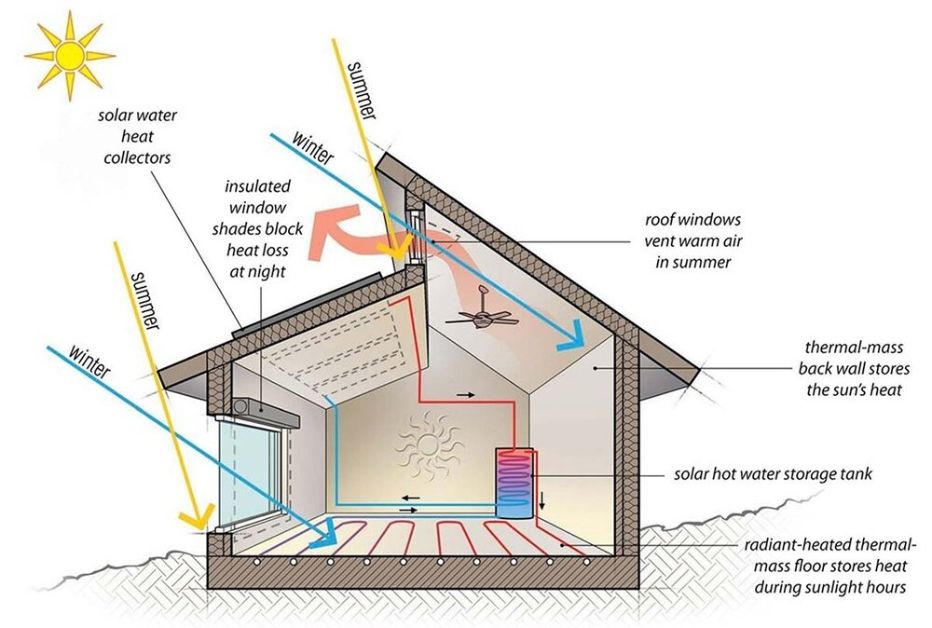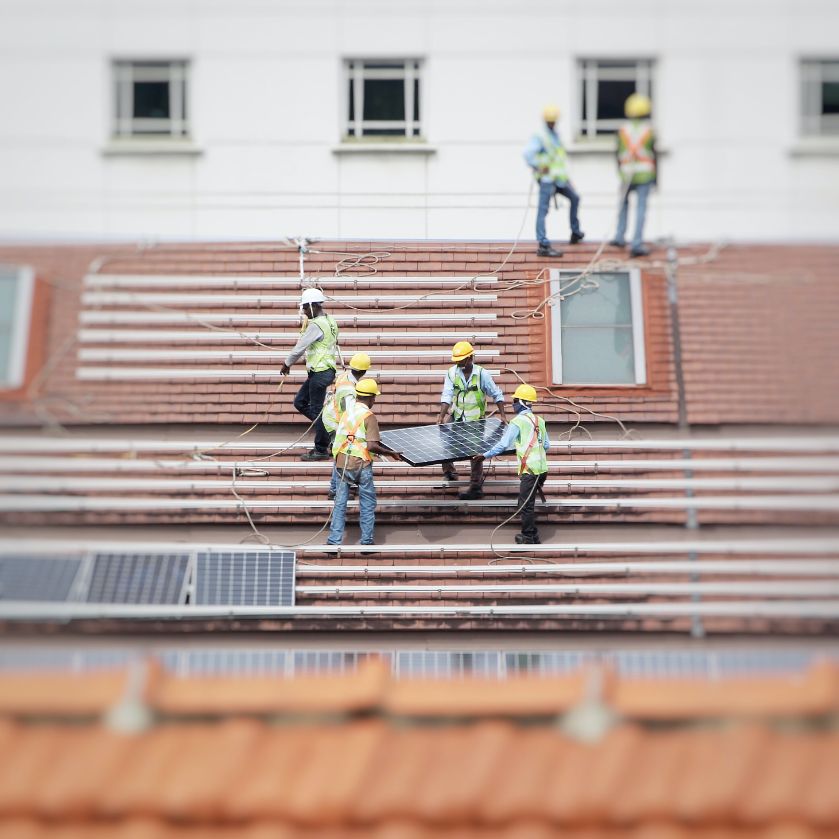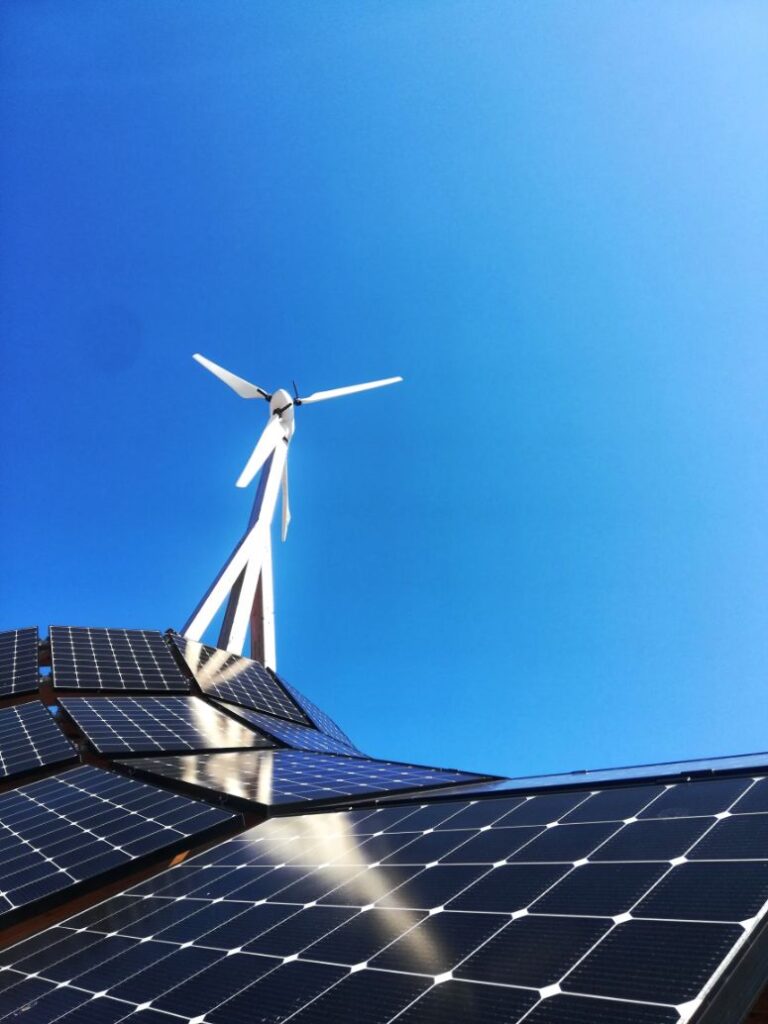The term “passive solar” refers to the direct use of solar energy for either heating or cooling purposes. Passive solar does not involve energy gathering or transformation through mechanical or electronic means, unlike photovoltaic or other technological solar power applications. Passive solar can be done in many different ways. Although it is most frequently used for home heating, it is also used in data centers.
In order to use as little energy as possible, passive solar design makes use of a building’s location, climate, and materials. A well-designed passive solar home reduces its heating and cooling demands through energy-saving measures before supplying all or a portion of those demands with solar energy. For more information on passive solar energy, please read this article.
How Does Passive Solar Heating Function?
The passive nature of a passive solar-heated home is one of its main benefits. When the components of a passive solar heating system are in place, the house begins to heat itself, quietly and with little assistance from humans. Here are a few crucial points to remember.
Energy Efficiency
The energy you never use is the cheapest kind of energy. Investing in energy efficiency is the first step in designing a house for passive solar.
Well-sealed doors and windows, double or triple-pane windows, energy-efficient appliances, and water heaters, and superior insulation are essential components of a passive solar home. A well-insulated home can reduce heating and cooling costs by up to 20% on its own. A house with tighter seals is also healthier because it is less susceptible to pests, viruses, bacteria, odors, and other air and noise pollutants.
Good Siting, Good Windows
When not blocked by trees, tall buildings, or other structures, south-facing windows in the Northern Hemisphere receive the most sunlight. (Gain more solar exposure by collaborating with your neighbors on a solar easement.) It is suggested that plants receive six hours of midday direct sunlight for heating. Window shades, awnings, and other coverings can help keep the house cool during the warmer months.
Tilted glass, as found in skylights on sloped roofs, performs better than vertical glass in colder climates with less southern sun exposure. Even in coastal climates, the diffuse solar radiation produced by regular cloud cover can produce significant levels of heat that well-tilted windows can capture.
Triple-glazed windows are becoming more prevalent, particularly in newly constructed buildings. Inert, safe gases are frequently used to fill the space between glazing layers to reduce heat loss.

In cold weather, windows that have received special treatment can raise window temperatures by up to 15 degrees F, further lowering heating costs. Naturally, keeping windows and skylights clean also helps.
Good Air Circulation
Knowing that heat moves from hot to cold does not require understanding the second law of thermodynamics. Warm air will move around the house into colder areas, much like hurricanes and cyclones do as they move from the equator toward the poles.
Without using mechanical or electrical air-circulation systems, truly passive homes simply let entropy run its course. Fans, ducts, and blowers may be used in other passive solar-heated and cooled homes. “Thermal bridges,” such as walls made of building materials that are highly conductive, also allow heat to pass from one room to another.
Additionally, air circulation brings filtered fresh air from the outside in with little heat gain (or loss). To prevent condensation and keep the home mold-free, proper air circulation is also crucial.
Heat Storage
Known as thermal mass, the building materials used to construct the home (such as the concrete slabs, brick walls, tile floors, and drywall, but also home furnishings) absorb heat from the sun and release it into the home at night or during the colder months. When a home needs to be cooled during the warmer months, thermal mass absorbs and stores heat from within. Darker hues absorb heat more readily than lighter ones on the floor or on the wall.
Temperatures inside a house are kept steady by thermal mass. The temperature in a room in a passive solar home fluctuates less than in homes that need to burn a lot of fuel to raise it from 63 to 69 degrees F on a cold morning. Naturally, changing a room’s temperature by one degree rather than by six does not require nearly as much energy as maintaining a stable temperature in the home.
Temperature Controls
Both the outside temperature and the amount of solar radiation entering a passive solar-heated home affect the interior temperature. Compared to a cloudy day in late spring, a sunny winter day may feel warmer indoors. Similar to how a sunny day in early spring can feel hotter inside than a cloudy day in midsummer.
A louvered vent in the roof can dissipate excess heat, and an awning or pergola over windows with southern exposure can offer seasonal shading. Heat controls help balance these variations.
Similar to how tall shrubs can block winter winds, they can also be used as privacy hedges. Since they are mostly self-regulating, these controls can be implemented with little to no human involvement.
Limitations Of Passive Solar Heating
Although there are some locations where passive solar heating and cooling perform better than others, it actually works in more locations than you might think because of its effectiveness and simplicity. However, there are restrictions.
Sustained, Not Immediate, Heat

Instead of providing instantaneous heat when needed, passive solar homes function by maintaining a comfortable living environment. While well-designed homes in desirable locations can occasionally rely solely on passive solar heating, the majority of passive solar heating systems serve as base-load heating while mechanical systems (heat pumps, electric heat, wood stoves, etc.) provide peak heating.) are used to provide heat on demand.
Location, Location, Location
Location matters in real estate as it does in everything else. A home may need additional heating in the winter in northern latitudes, and additional cooling in the summer in southern latitudes. Climate must be considered in building design.
However, houses frequently have sloping roofs in northern latitudes, increasing their exposure to solar radiation from the skydome’s upper regions. The amount of hours that a roof receives direct sunlight is greater for a roof with an inverted V shape than for a flat roof.
Upfront Costs And Payback Times
It can be expensive to build a building or retrofit an existing one, but not always. A new passive solar home only adds 3% to 5% to the overall cost of construction. There is a sizable potential market for passive solar heating and cooling since 1.4 million new homes are constructed annually in the United States.
It is more difficult (and expensive) to retrofit a home for passive solar than it is to build one from scratch because the majority of the advantages of a passive solar-heated home are in the design and construction of the building.
Based on how much sunlight the building receives and the frequently fluctuating cost of heating and cooling, the return on investment is a reduction in heating and cooling expenses. The return on investment was as low as 7.7 years in a building that underwent retrofitting in a northern climate and saw a 45% reduction in energy consumption. The payback period was 13 years in an area with a milder climate.
In either case, the long-term advantages outweighed the disadvantages.
Does Passive Solar Make Financial Sense?
When purchasing or constructing a new home, passive solar heating is one of the best investments you can make. Passive solar heating systems are cost-effective; research has shown that they can result in annual savings for a gas-powered home of between $150 and 380 dollars. Similarly to this, an oil-heated home can expect to save between $210 and 520 dollars annually.
It’s important to note that passive solar is something you should consider when buying a new home or building one–not for installing in your current home. To reposition windows, roof overhangs, and other elements of your home’s interior in order to install a passive solar heating system, you would need to completely tear down your house. Therefore, eliminate that choice from consideration.
What Is The Difference Between Active And Passive Solar Energy?

The primary distinction between active and passive solar energy is that active energy involves a process of energy transformation. Passive solar energy, on the other hand, doesn’t use any machinery or electricity.
With regard to photovoltaic panels, we convert sunlight into electrical power. Using thermal solar panels, on the other hand, we transform radiation into heat energy.
The method known as passive solar energy enables you to use solar energy without first processing it. The amount of natural energy used, for instance, can be greatly increased depending on the design used in building construction.
Further Reading: Active Solar Energy VS Passive Solar Energy: Which Is Better?
Passive Solar Home Design For Summer Comfort
A skilled passive solar home designer will consider both winter heating and summer comfort. Design and siting considerations for a passive solar home depend on the local climate.
For most climates, blocking summer solar heat gain will require the use of an overhang or other structures like awnings, shutters, and trellises. During the cooling season, landscaping can also help keep your passive solar home comfortable. Consult an architect who is knowledgeable about passive solar design if you’re thinking about using it for a new house or a significant remodel.
What Is The Future Of Passive Solar Heating?
Why don’t most Americans own a home that utilizes passive solar heating when the technology has been around for decades and recent design advancements have improved efficiency at every stage of the process?
First of all, setting up the necessary infrastructure and making the initial investment required to use passive solar heating are both time-consuming tasks. But the majority of home improvement tasks do as well, and this one can help you save a ton of cash. That leads us to the second reason:
Passive solar hasn’t received enough attention. Passive solar results in lower greenhouse gas emissions while also saving money, so the practicality is there. However, it has not gained popularity in the same way that natural gas heating or even rooftop solar panels have. That will alter soon.
We should anticipate that more people will benefit from lowering their environmental impact and saving money on their heating bills as the world becomes more environmentally conscious. The benefits of using solar energy only increase as our technology becomes more effective.
